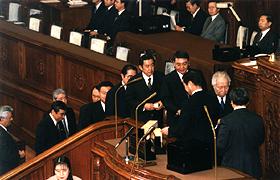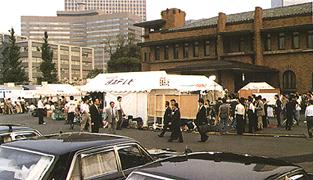(2) Composition of the Cabinet
The Constitution provides, "The Cabinet shall consist of the Prime Minister, who shall be its head, and other Ministers of State, as provided by law." (First paragraph of Article 66). The Cabinet is an administrative organ for consultation, and presided over by the Prime Minister. According to the Cabinet Law, the number of Ministers of State constituting the Cabinet, except the Prime Minister, shall be within 14. When a special need arises, however, the number of Ministers can be increased by up to three to make the upper limit 17.
 |
Singed ballot to designate the Prime Minister
at the plenary session of the House of Representatives |
(a) From the Designation of the Prime Minister to the Inauguration of the New Cabinet
The Prime Minister shall be designated from among the members of the Diet by a resolution of the Diet.
A Diet member who acquires majority votes in a single signed ballot shall be designated as Prime Minister. When no one obtains majority votes in the first round ballot, a run-off ballot shall be conducted between the two top vote-getters in the first round.
If the House of Representatives and the House of Councillors disagree and if no agreement can be reached even through a joint committee of both Houses, or the House of Councillors fails to make designation within ten days, exclusive of the period of recess, after the House of Representative has made designation, the decision of the House of Representatives shall be the decision of the Diet.
A Prime Minister-designate by the Diet resolution shall immediately initiate a process to choose Ministers of State (called "Sokaku," formation of the Cabinet) at the Prime Minister's Official Residence.
As the selection of Ministers of State is completed, an imperial investiture to appoint the Prime Minister shall be conducted, followed by an attestation ceremony for ministerial appointments, at the Imperial Court.
After the imperial investiture for the Prime Minister and the attestation ceremony for the Ministers of State, the Prime Minister shall give the Ministers the letters of appointment at the Prime Minister's Official Residence.
Immediately after the delivery of the letters of appointment, the first Cabinet meeting shall be held to deal with such matters as the content of Prime Minister's comments at the inauguration of the Cabinet, the observers of the Cabinet meeting and the rules concerning the prohibition of concurrent offices.
[ Change in Members of the Cabinet Meeting ]
The Cabinet meeting when the Cabinet system was newly created was attended by the Prime Minister and the ten Ministers of State. The number of the Ministers has changed due to consolidation and creation of ministries. Besides, the so-called Ministers without portfolio constituted the Cabinet in accordance with Article 10 of Naikaku-kansei that allowed such Ministers for a special purpose. Initially, there was no provision to regulate the number of Ministers without portfolio, but later an imperial decree set the limit of three. When the Cabinet Law entered into force, the number was limited to six. In the intervening period, there were three revisions about the number of Ministers without portfolio.
The Cabinet Law effectuated in 1947 originally stipulated that the Cabinet was comprised of the Prime Minister, the head of the Cabinet, and up to 16 Ministers of States. Currently, through the revisions of the Cabinet Law five times, the number of Ministers of State shall be within 14, and it can be increased by up to three to make the upper limit 17 when a special need arises.
| Date of Enforcement | Number of Cabinet members stipulated by the Cabinet Law |
| December 22, 1943 | 10 ministers including the Prime Minister
(Imperial Household Minister was not included.) |
| May 3, 1947 | Within 16 ministers excluding the Prime Minister
(The Cabinet Law entered into force.)
|
| May 19, 1965 | Within 17 ministers
(The Cabinet Law was revised and the Director General of the Prime Minister's Office became a Minister of State)
|
| June 28, 1966 | Within 18 ministers
(The Cabinet Law was revised and the Chief Cabinet Secretary became a Minister of State)
|
| July 9, 1971 | Within 19 ministers
(The Cabinet Law was revised and the Director General of the Environment Agency was added)
|
| June 24, 1974 | Within 20 ministers
(The Cabinet Law was revised and the Director General of the National Land Agency was added)
|
| January 6, 2001 | Within 14 ministers
(The Cabinet Law was revised along with the reorganization of central ministries and agencies. The number of Ministers of State can be increased by up to three to make the upper limit 17 when a special need arises.)
|
|
(b) Cabinet Reshuffle
A cabinet reshuffle is a change of all or part of the Cabinet members except the Prime Minister with the purpose of bringing new personnel into the Cabinet. The Constitution allows the Prime Minister the power to appoint and dismiss Ministers of State. On this occasion, the Ministers of State are sought to tender their resignations at a Cabinet meeting (generally called the collection of resignations).
A process to choose, appoint and attest the new Ministers of State upon a cabinet reshuffle is the same as that in an original cabinet formation.
|
(c) Resignation of the Cabinet
A resignation of the Cabinet not only means the resignation of the Prime Minister alone but rather the resignation of all Cabinet members en masse.
The Cabinet can unilaterally decide a resignation of the Cabinet en masse, but shall notify such a decision to the Diet. Cases where the Cabinet resign en masse are as follows:
- If the House of Representatives passes a no-confidence resolution, or rejects a confidence resolution
The Cabinet shall resign en masse, unless the House of Representatives is dissolved within ten days. (Article 69 of the Constitution)
- Upon the first convocation of the Diet after a general election of members of the House of Representatives
This is because the Cabinet comes to lose its foundation as members of the House of Representatives, which designated the Prime Minister, are reelected. Renewed confidence from the Diet is required
Even if the ruling parties win majority votes in a general election and the Diet is expected to designate the current Prime Minister again, the Cabinet must resign en masse to renew the foundation of confidence. (Article 70 of the Constitution)
- When there is a vacancy in the post of Prime Minister
When there is a vacancy in the post of Prime Minister, due to death or disqualification (by losing a seat in the Diet) for example, the Cabinet shall resign en masse. (Article 70 of the Constitution)
- When the Prime Minister expresses his or her intention of resignation
The Prime Minister may express his or her intention of resignation because of sickness or other reasons. The Cabinet also resigns en masse in such a case.
(d) Cabinet after a Resignation En Masse
(The so called "Shokumu-Shikko-Naikaku," or a routine function Cabinet)
According to Article 71 of the Constitution, the Cabinet shall continue its functions until the time a new Prime Minister is appointed. The purpose is to prevent the administration from piling up even temporarily. The Cabinet after a resignation en masse is destined to disappear as a new Prime Minister is appointed. It is therefore expected to do no more than perform jobs necessary for the continuation of the administration and to refrain from actively pursuing new policies.
|
